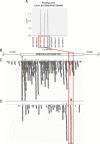Small RNA discovery in the interaction between barley and the powdery mildew pathogen
- PMID: 31345162
- PMCID: PMC6657096
- DOI: 10.1186/s12864-019-5947-z
Small RNA discovery in the interaction between barley and the powdery mildew pathogen
Erratum in
-
Correction to: small RNA discovery in the interaction between barley and the powdery mildew pathogen.BMC Genomics. 2019 Sep 4;20(1):697. doi: 10.1186/s12864-019-6012-7. BMC Genomics. 2019. PMID: 31484492 Free PMC article.
Abstract
Background: Plants encounter pathogenic and non-pathogenic microorganisms on a nearly constant basis. Small RNAs such as siRNAs and miRNAs/milRNAs influence pathogen virulence and host defense responses. We exploited the biotrophic interaction between the powdery mildew fungus, Blumeria graminis f. sp. hordei (Bgh), and its diploid host plant, barley (Hordeum vulgare) to explore fungal and plant sRNAs expressed during Bgh infection of barley leaf epidermal cells.
Results: RNA was isolated from four fast-neutron immune-signaling mutants and their progenitor over a time course representing key stages of Bgh infection, including appressorium formation, penetration of epidermal cells, and development of haustorial feeding structures. The Cereal Introduction (CI) 16151 progenitor carries the resistance allele Mla6, while Bgh isolate 5874 harbors the AVRa6 avirulence effector, resulting in an incompatible interaction. Parallel Analysis of RNA Ends (PARE) was used to verify sRNAs with likely transcript targets in both barley and Bgh. Bgh sRNAs are predicted to regulate effectors, metabolic genes, and translation-related genes. Barley sRNAs are predicted to influence the accumulation of transcripts that encode auxin response factors, NAC transcription factors, homeodomain transcription factors, and several splicing factors. We also identified phasing small interfering RNAs (phasiRNAs) in barley that overlap transcripts that encode receptor-like kinases (RLKs) and nucleotide-binding, leucine-rich domain proteins (NLRs).
Conclusions: These data suggest that Bgh sRNAs regulate gene expression in metabolism, translation-related, and pathogen effectors. PARE-validated targets of predicted Bgh milRNAs include both EKA (effectors homologous to AVRk1 and AVRa10) and CSEP (candidate secreted effector protein) families. We also identified barley phasiRNAs and miRNAs in response to Bgh infection. These include phasiRNA loci that overlap with a significant proportion of receptor-like kinases, suggesting an additional sRNA control mechanism may be active in barley leaves as opposed to predominant R-gene phasiRNA overlap in many eudicots. In addition, we identified conserved miRNAs, novel miRNA candidates, and barley genome mapped sRNAs that have PARE validated transcript targets in barley. The miRNA target transcripts are enriched in transcription factors, signaling-related proteins, and photosynthesis-related proteins. Together these results suggest both barley and Bgh control metabolism and infection-related responses via the specific accumulation and targeting of genes via sRNAs.
Keywords: Barley; Blumeria; CSEPs; EKA family; Pathogen effectors; Small RNA-Seq; Transposable elements.
Conflict of interest statement
The authors declare that they have no competing interests.
Figures






Similar articles
-
Allelic barley MLA immune receptors recognize sequence-unrelated avirulence effectors of the powdery mildew pathogen.Proc Natl Acad Sci U S A. 2016 Oct 18;113(42):E6486-E6495. doi: 10.1073/pnas.1612947113. Epub 2016 Oct 4. Proc Natl Acad Sci U S A. 2016. PMID: 27702901 Free PMC article.
-
Evolution of the EKA family of powdery mildew avirulence-effector genes from the ORF 1 of a LINE retrotransposon.BMC Genomics. 2015 Nov 10;16:917. doi: 10.1186/s12864-015-2185-x. BMC Genomics. 2015. PMID: 26556056 Free PMC article.
-
The leucine-rich repeats in allelic barley MLA immune receptors define specificity towards sequence-unrelated powdery mildew avirulence effectors with a predicted common RNase-like fold.PLoS Pathog. 2021 Feb 3;17(2):e1009223. doi: 10.1371/journal.ppat.1009223. eCollection 2021 Feb. PLoS Pathog. 2021. PMID: 33534797 Free PMC article.
-
Specific Resistance of Barley to Powdery Mildew, Its Use and Beyond. A Concise Critical Review.Genes (Basel). 2020 Aug 21;11(9):971. doi: 10.3390/genes11090971. Genes (Basel). 2020. PMID: 32825722 Free PMC article. Review.
-
Pyrenophora teres: profile of an increasingly damaging barley pathogen.Mol Plant Pathol. 2011 Jan;12(1):1-19. doi: 10.1111/j.1364-3703.2010.00649.x. Mol Plant Pathol. 2011. PMID: 21118345 Free PMC article. Review.
Cited by
-
Long noncoding RNAs emerge from transposon-derived antisense sequences and may contribute to infection stage-specific transposon regulation in a fungal phytopathogen.Mob DNA. 2023 Nov 15;14(1):17. doi: 10.1186/s13100-023-00305-6. Mob DNA. 2023. PMID: 37964319 Free PMC article.
-
Role of phasiRNAs in plant-pathogen interactions: molecular perspectives and bioinformatics tools.Physiol Mol Biol Plants. 2022 May;28(5):947-961. doi: 10.1007/s12298-022-01189-1. Epub 2022 May 27. Physiol Mol Biol Plants. 2022. PMID: 35722509 Free PMC article. Review.
-
Identification of MicroRNAs and Their Targets That Respond to Powdery Mildew Infection in Cucumber by Small RNA and Degradome Sequencing.Front Genet. 2020 Mar 26;11:246. doi: 10.3389/fgene.2020.00246. eCollection 2020. Front Genet. 2020. PMID: 32273882 Free PMC article.
-
Disruption of barley immunity to powdery mildew by an in-frame Lys-Leu deletion in the essential protein SGT1.Genetics. 2021 Feb 9;217(2):iyaa026. doi: 10.1093/genetics/iyaa026. Genetics. 2021. PMID: 33724411 Free PMC article.
-
Biogenesis, Functions, Interactions, and Resources of Non-Coding RNAs in Plants.Int J Mol Sci. 2022 Mar 28;23(7):3695. doi: 10.3390/ijms23073695. Int J Mol Sci. 2022. PMID: 35409060 Free PMC article. Review.
References
-
- Amselem J, Vigouroux M, Oberhaensli S, Brown JK, Bindschedler LV, Skamnioti P, Wicker T, Spanu PD, Quesneville H, Sacristan S. Evolution of the EKA family of powdery mildew avirulence-effector genes from the ORF 1 of a LINE retrotransposon. BMC Genomics. 2015;16:917. doi: 10.1186/s12864-015-2185-x. - DOI - PMC - PubMed
MeSH terms
Substances
Grants and funding
LinkOut - more resources
Full Text Sources
Molecular Biology Databases

